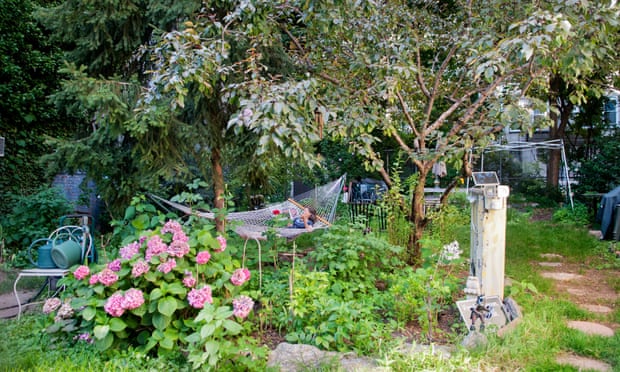On a hot summer’s day, the sun beats down through a canopy of fruit trees and the breeze carries the smell of roasting pork. Birdsong can be heard alongside salsa music. But this is no Caribbean island – this is downtown Manhattan.
“When you come here, you swear you are in Puerto Rico,” says Marta Montañez, who has lived in and around the Lower East Side for 62 years, after immigrating to the US when she was six.
As a member of two of the neighbourhood’s gardens with strong Latino heritage, Montañez has been able to find a slice of island life on Avenue C. “It really is a paradise, it’s an escape,” she says.
Founded in 1979, the community garden at 9th and C is one of the oldest and grandest in the neighbourhood. A botanical garden overflowing with flowers, vegetables and herbs, there is a grape arbour, an outdoor kitchen with a miniature tea set, cherry and peach trees and a pond with fish and turtles.
A towering dead willow tree is a reminder of the water that flooded and contaminated the garden during hurricane Sandy. Today the gardeners are preparing to host a party for one of the members who has gardened here for 30 years. Last week, it was a free salsa party with a live band and dancing that attracted about 300 people.
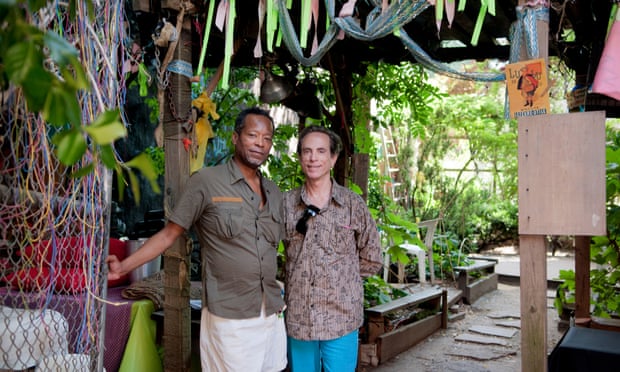
The first community gardens began to crop up in the Lower East Side – the area south of 14th street and east of the Bowery, encompassing what has more recently become known as the East Village – in the 1970s, when the city went bankrupt.
Buildings in the Lower East Side – or Loisaida, as the Latino community call it – were abandoned, or torched by landlords for insurance purposes, turning the area into a hotspot for drugs and crime.
Amid the blight, residents cleaned up the vacant lots, rejuvenating the area and creating safe, green spaces where they could grow food, relax and convene. Self-styled “green guerrillas” threw seed bombs onto these lots, while horse manure from Central Park was collected and used as fertilizer.
As the movement grew, the city launched Operation GreenThumb in 1979, taking back legal control over the community gardens by issuing short-term leases to the gardeners and offering resources to create and maintain them.
Today, 39 of these gardens remain in the Lower East Side – the highest concentration in the city, which has about 600 in total. Nestled among the rows of tenement buildings, they are the heart and lungs of the densely packed neighbourhood.
Volunteers pay a membership fee to join a garden and commit to looking after and keeping the gardens open for set numbers of hours a week under GreenThumb’s criteria.
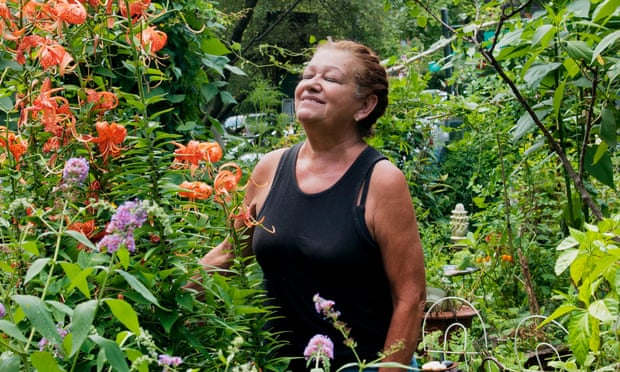
Over the summer months, the gardens host a movable feast of cultural activities – including movie screenings, plays, exhibitions, talks, music and barbecues that reflect the rich diversity of the artistic neighbourhood, which has long been a gateway for immigrants entering New York.
The narrow and neatly gardened space recently added two urban beehives. “It’s random people who end up here – you may not have anything in common with them, but you come together to share a space,” she says. “They help build bridges in the community.”
With the organisation required to create and protect the spaces, many of the gardens have become homes to social and political activism. Le Petit Versailles, on East Houston Street, was established in 1996 as a LGBTQ community arts garden, by artists and collaborative partners Peter Cramer and Jack Waters.
“This garden started to take momentum as a public social space after the events of 9/11,” says Waters. “There was a need for a community, social space and political interaction.
“Simultaneously, there was also the galvanising of the queer community and queer politics; that meant the garden very much became a hub for our culture and politics,” he says.
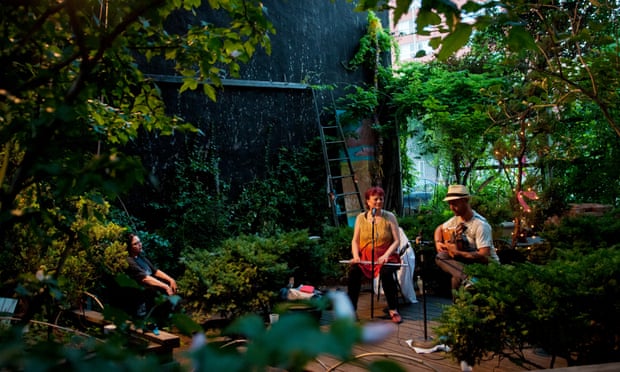
When the Republican National Convention came to the city in 2004 – sparking large protests – activists and protesters were invited to seek refuge and regroup in the garden. “There really is a sense of enclosure and protection. You can feel it – it’s visceral,” says Waters.
In the mid-afternoon, light trickles through the leaves of the mulberry trees, illuminating the various curios, sculptures and remnants from previous art exhibitions that have become entwined in the shady garden. All summer it hosts a packed programme of cultural events that attract people from around the world. “It’s a lived history,” says Waters.
One of the unavoidable consequences of the locals’ cleaning up and beautifying the neighbourhood is that the land became attractive to developers, most acutely under former mayor Rudolph Giuliani, who specifically targeted the gardens, inspiring many protests.
Elizabeth Ruf-Maldonado, a theatrical director, professor and community activist, remembers seeing a garden opposite her apartment in 8th street – a large plot where about 50 households gardened – flattened by bulldozers to make way for a housing development.
After the garden was destroyed in 1996, Ruf-Maldonado and a few other neighbours began clearing a plot opposite, which had been used as a toilet and garbage heap and was filled with needles, to create De Colores Community Yard.
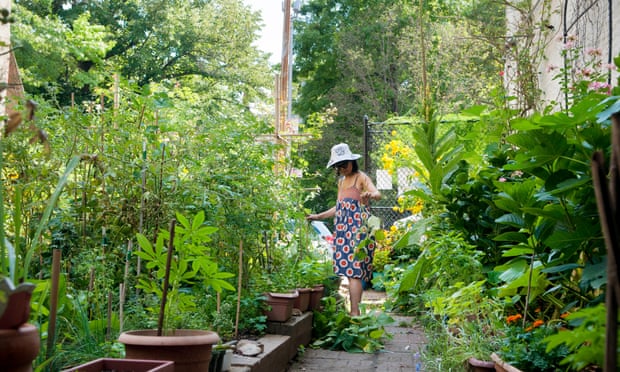
Today the plot, with its hammock, lawn and pink plastic flamingos, has an almost suburban feel – a laissez-faire vibe. “You can mow here, which, when you live in the city, is actually pretty fun,” says Ruf-Maldonado.
The future of these spaces is a perennial concern for the gardeners, who have to renew their GreenThumb licenses every four years. They are organising to gain official recognition for the Lower East Side’s gardens and the first Community Garden District.
Charles Krezell, film-maker, founder of Loisaida United Neighborhood Gardens(Lungs) and co-founder of De Colores, has been working with Ruf-Maldonado to map out a network of community gardens.
“We have to make the gardens more attractive, more active and more valuable within the community, expanding the gardens in such a way that they are looked on as a resource, not an eyesore, not a potential development but green space for the city – and we are hurting for green space,” says Krezell.
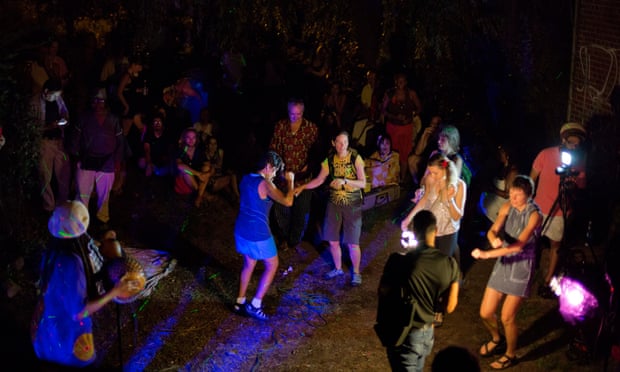
In January the community board unanimously voted in favour of creating the Community Garden District, but the plans are “a little controversial”, explains Ruf-Maldonado: “The worry some have is that if this is called a garden district, it will become a destination for tourism and rich people will want to buy here.
“My feeling is that it would have to be tied to tenant activism,” she says, “like becoming more active about the things we need, like stronger rent laws and positive zoning.”
But as the neighbourhood has gentrified, rising rents over the past 20 years have forced out some existing communities and families that formed the backbone of the gardens, creating a membership pipeline challenge. Newer residents, many of whom are students, tend to be more transient, staying for one or two years. With the original gardeners and activists ageing, and maintaining the gardens being a labour- and time-intensive task, recruiting the next generation of volunteers will be vital for ensuring the gardens continue to bloom.
Krezell hopes Lungs’s paid summer job scheme for high school students to work in the gardens – a “baptism of mud”, as he describes it – can help plug the gap.
“It’s about generational education,” says Krezell. “It’s not all about the virtual computer world. It’s real shit right here – get your hands dirty and appreciate it.”
